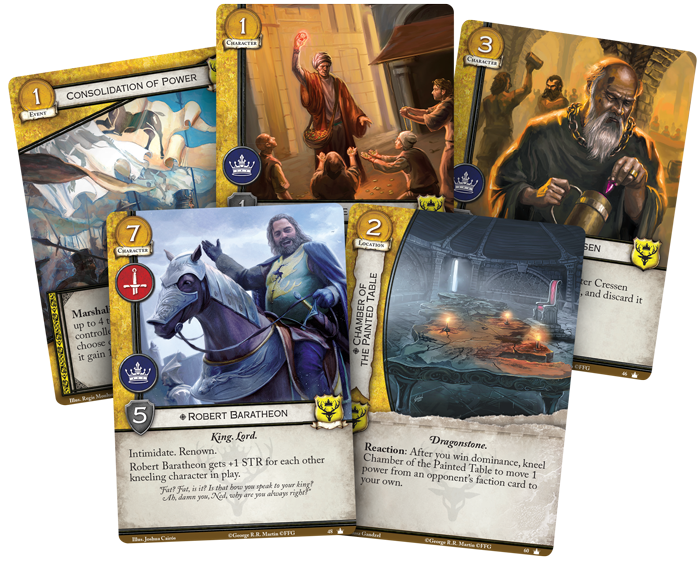

 429 games
429 games
 53.61% win
53.61% win
 1479 points
1479 points
 0.008 QR
0.008 QR
With the death of Mad King Aerys and the ousting of the Targaryens, a new House became the sovereigns of the Seven Kingdoms.
Robert Baratheon ascended the Iron Throne in King’s Landing and became the new king, while his brothers held the citadels of Dragonstone and Storm’s End in his name. At the beginning of A Song of Ice and Fire, the power of House Baratheon is beginning to slip away as House Lannister and others plot behind the scenes.
In general, the Baratheons try to subdue, avoid, and appease threats, using kneeling tactics instead of killing or harming their subjects.
At the heart of it, House Baratheon exists in a position of privilege and entitlement (which makes them good at winning dominance), and they want things to stay the way they are. There is a little bit of a reverse-landslide mentality guiding this faction – House Baratheon is trying to prevent everything they’ve gained from falling apart.

Kneel, Intimidate, Dominance, Passive Power, Control
Robert Baratheon (Core) is a monster in challenges because of his plus strength bonus and keywords. He grows stronger as surrounding characters kneel (thematically bending the knee -- it's good to be the King). Stannis Baratheon (Core) locks down a large board, allowing you to focus on appeasing fewer threats each round. Both Robert and Stannis are vulnerable to Tears of Lys, but you can shore up that weakness with Bodyguard, Little Bird, or Selyse Baratheon (Core).
The Red Keep (Core) and Moon Boy demonstrate the Baratheon’s commitment to power challenges (the blue crown icon). They need to win power challenges consistently, or at least not lose, in order to draw cards.
Melisandre (Core) is a repeatable “engine” and still powerful in 2023 decks. Provided you can marshal or play a card with the R’hllor trait once per round, you then kneel any opposing threat (a kind of temporary “soft” control). Other noteworthy R’hllor cards include Lightbringer (Core), a weapon that’s fantastic on Robert or Stannis, and Seen in Flames (Core), a powerful hand control event. You want to find Melisandre quickly, usually through a plot like Summons (Core), and focus on keeping her alive -- beware of Dracarys! (Core) and Put to the Sword (Core). There are also a few non-R'hllor kneel cards, like Even Handed Justice and Consolidation of Power (Core).
The Baratheon’s also feature a dominance-winning module. They use cards like The Iron Throne (Core) and Fiery Followers (Core) to have the highest standing strength plus remaining gold during the dominance phase, which will earn them one power towards the victory total. Then cards like Gendry, Tobho Mott’s Armory, Chamber of the Painted Table (Core) and Feast for Crows (Core) give you extra benefits for winning dominance.
† References above provided by scantrell24
The Friendly Council is a deckbuilding series for A Game of Thrones: The Card Game (Second Edition). This is a new Friendly Open project, aimed at helping beginner and intermediate-level players build their own decks.
- Baratheon / Fealty by Tsarcastic
- Baratheon / Brotherhood Without Banners by JiÅ™í Drábek
This deck is made by JiÅ™í Drábek, which has bursted into the competitive scene with Friendly Open. JiÅ™í (JP Profile), has used his Brotherhood deck to get very good results in the Friendly Open, and is one of the players who's put Baratheon back into the top of the tournament rankings.
- Baratheon / Knigts of the Hollow Hill (321) by Miha Vrbanec
Miha is considered to be one of the most creative deck builders and players in the scene. Miha plays a huge variety of decks, and tries to pull off crazy things like this: Tycho Nestoris feat Odrl.
- Baratheon / House with the Red Door by Odrl and The Friendly Council